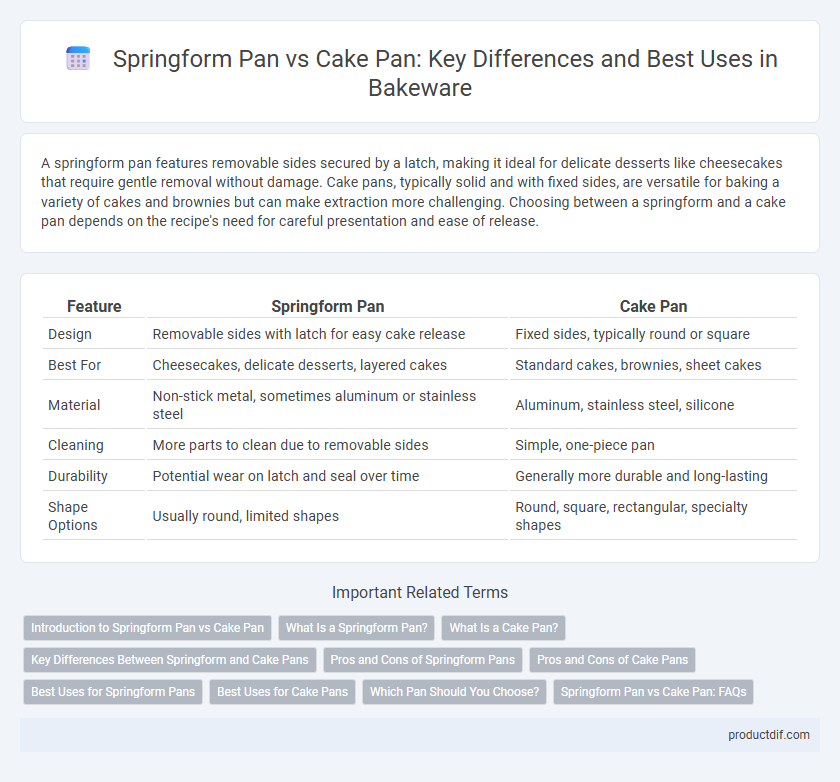A springform pan features removable sides secured by a latch, making it ideal for delicate desserts like cheesecakes that require gentle removal without damage. Cake pans, typically solid and with fixed sides, are versatile for baking a variety of cakes and brownies but can make extraction more challenging. Choosing between a springform and a cake pan depends on the recipe's need for careful presentation and ease of release.
Table of Comparison
| Feature | Springform Pan | Cake Pan |
|---|---|---|
| Design | Removable sides with latch for easy cake release | Fixed sides, typically round or square |
| Best For | Cheesecakes, delicate desserts, layered cakes | Standard cakes, brownies, sheet cakes |
| Material | Non-stick metal, sometimes aluminum or stainless steel | Aluminum, stainless steel, silicone |
| Cleaning | More parts to clean due to removable sides | Simple, one-piece pan |
| Durability | Potential wear on latch and seal over time | Generally more durable and long-lasting |
| Shape Options | Usually round, limited shapes | Round, square, rectangular, specialty shapes |
Introduction to Springform Pan vs Cake Pan
Springform pans feature removable sides secured with a latch, allowing delicate cakes like cheesecakes and tortes to be easily released without damage. Traditional cake pans have fixed sides, ideal for standard cakes that can be inverted for easy removal. Choosing between them depends on the cake type and the desired ease of removal and presentation.
What Is a Springform Pan?
A springform pan features removable sides secured by a latch, allowing easy release of delicate cakes without damaging their shape. Commonly used for cheesecakes and tortes, it enables smooth removal by simply unclipping the sides. Unlike traditional cake pans, the springform design prevents the need to invert the cake for serving, preserving intricate details and layers.
What Is a Cake Pan?
A cake pan is a versatile bakeware essential designed for baking various types of cakes, typically made from metal, glass, or silicone to ensure even heat distribution and consistent baking. It features fixed sides and a solid base, which helps shape the batter into uniform layers or shapes, ideal for sheet cakes, layered cakes, and other traditional cake recipes. Unlike a springform pan, a cake pan does not have removable sides, making it less suitable for delicate or easily crumbled desserts but perfect for sturdy cakes that can be inverted or cooled before slicing.
Key Differences Between Springform and Cake Pans
Springform pans feature removable sides secured by a latch, allowing delicate cakes like cheesecakes to be released easily without flipping, while traditional cake pans have fixed sides that require inverting to remove the cake. Springform pans typically come with a non-stick base to prevent sticking and provide a clean presentation, whereas cake pans are often made of aluminum or steel with various shapes suited for layered or sheet cakes. The key difference lies in the ease of removal and the types of baked goods each pan supports, with springform pans preferred for fragile, high-moisture desserts and cake pans used for standard sponge or butter cakes.
Pros and Cons of Springform Pans
Springform pans offer the advantage of easily removable sides, making them ideal for delicate cakes like cheesecakes and tortes that cannot be flipped out of traditional cake pans without damage. Their leak-resistant seals prevent batter spillage, though cheaper models may still require a baking sheet underneath to catch potential drips. However, springform pans can warp under high heat and are not as versatile as standard cake pans, which are better suited for a wide range of cake types and provide more even heat distribution for consistent baking results.
Pros and Cons of Cake Pans
Cake pans offer uniform heat distribution, ensuring even baking and consistent texture throughout the cake. Their solid sides provide excellent support for batter stability, making them ideal for layered cakes and dense batters, but they can make removing delicate cakes challenging without grease or parchment. Compared to springform pans, cake pans are more versatile and durable but lack the easy-release mechanism that simplifies removal of fragile or cheesecakes.
Best Uses for Springform Pans
Springform pans are ideal for delicate desserts such as cheesecakes, tortes, and layered cakes that require gentle removal without inverting. Their removable sides and base allow for easy release of fragile baked goods, preserving intricate designs and textures. This functionality makes springform pans the preferred choice for recipes with soft fillings that cannot be flipped or transferred from traditional cake pans.
Best Uses for Cake Pans
Cake pans are ideal for baking traditional layer cakes, brownies, and bars because their solid sides help maintain structure and promote even cooking. Made from materials like aluminum, stainless steel, or silicone, cake pans provide consistent heat distribution for uniform browning and texture. Their fixed edges make them perfect for recipes requiring easy stacking, precise shaping, and clean presentation.
Which Pan Should You Choose?
Choose a springform pan for delicate desserts like cheesecakes and tortes that require easy removal without flipping, thanks to its removable sides and bottom. Opt for a traditional cake pan when baking spongy cakes, brownies, or layered desserts, as its solid structure provides even heat distribution and sturdy support. Consider the recipe's texture and release method to determine the ideal bakeware for flawless results.
Springform Pan vs Cake Pan: FAQs
Springform pans feature removable sides and a latch mechanism ideal for delicate cheesecakes and layered desserts, while cake pans are solid and better suited for traditional cakes and brownies. Cleaning and maintenance differ, as springform pans have more crevices that require thorough washing to prevent residue buildup, whereas cake pans are simpler to clean. Choosing between a springform pan and a cake pan depends on the recipe's texture and presentation needs, skinning the surface without damaging soft or crumbly baked goods.
Springform Pan vs Cake Pan Infographic

 productdif.com
productdif.com